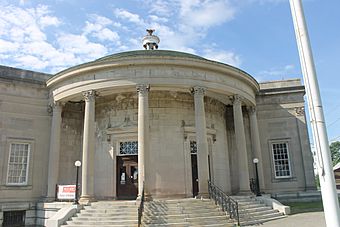Old Waterville Post Office facts for kids
Quick facts for kids |
|
|
Waterville Post Office
|
|
 |
|
| Location | 1 Post Office Sq., Waterville, Maine |
|---|---|
| Area | 0.5 acres (0.20 ha) |
| Built | 1911 |
| Architect | Taylor, James Knox |
| Architectural style | Greek Revival |
| NRHP reference No. | 77000074 |
| Added to NRHP | April 18, 1977 |
The Old Waterville Post Office is a special old building in Waterville, Maine. It was built in 1911 and looks like an ancient Greek temple! This building is so important that it was added to the National Register of Historic Places in 1977. Today, it's not a post office anymore. Instead, it's home to a restaurant and a place where they make drinks.
About the Building
The Old Waterville Post Office stands in a very noticeable spot in downtown Waterville. It's on a triangular piece of land where two main streets, Main Street and Elm Street, meet.
Building Design
This building is made of stone and has only one floor. It's shaped a bit like a bent rectangle. The part of the building that faces the street intersection is rounded. This rounded section has a row of fancy columns called Corinthian columns. These columns hold up a decorative band called an entablature.
The corners of the building also have flat, decorative columns called pilasters. These pilasters continue the same decorative band around the whole building.
Roof and Entrance
The rounded part of the building has a circular, dome-shaped roof. On top of the dome is a small, decorative tower. This tower looks like a famous ancient Greek monument called the Choragic Monument of Lysicrates. The rest of the building has a flat roof.
To get inside, you walk up a few low steps to two main entrances. These entrances are in the curved part of the building and have very fancy decorations around them.
History of the Post Office
The Waterville Post Office was designed by an architect named James Knox Taylor. At the time, he was in charge of designing many government buildings for the United States Department of the Treasury. The building was finished in 1911.
It is one of the best examples in Maine of Greek Revival architecture from the early 1900s. This style of architecture was popular because it looked back to the grand buildings of ancient Greece.



